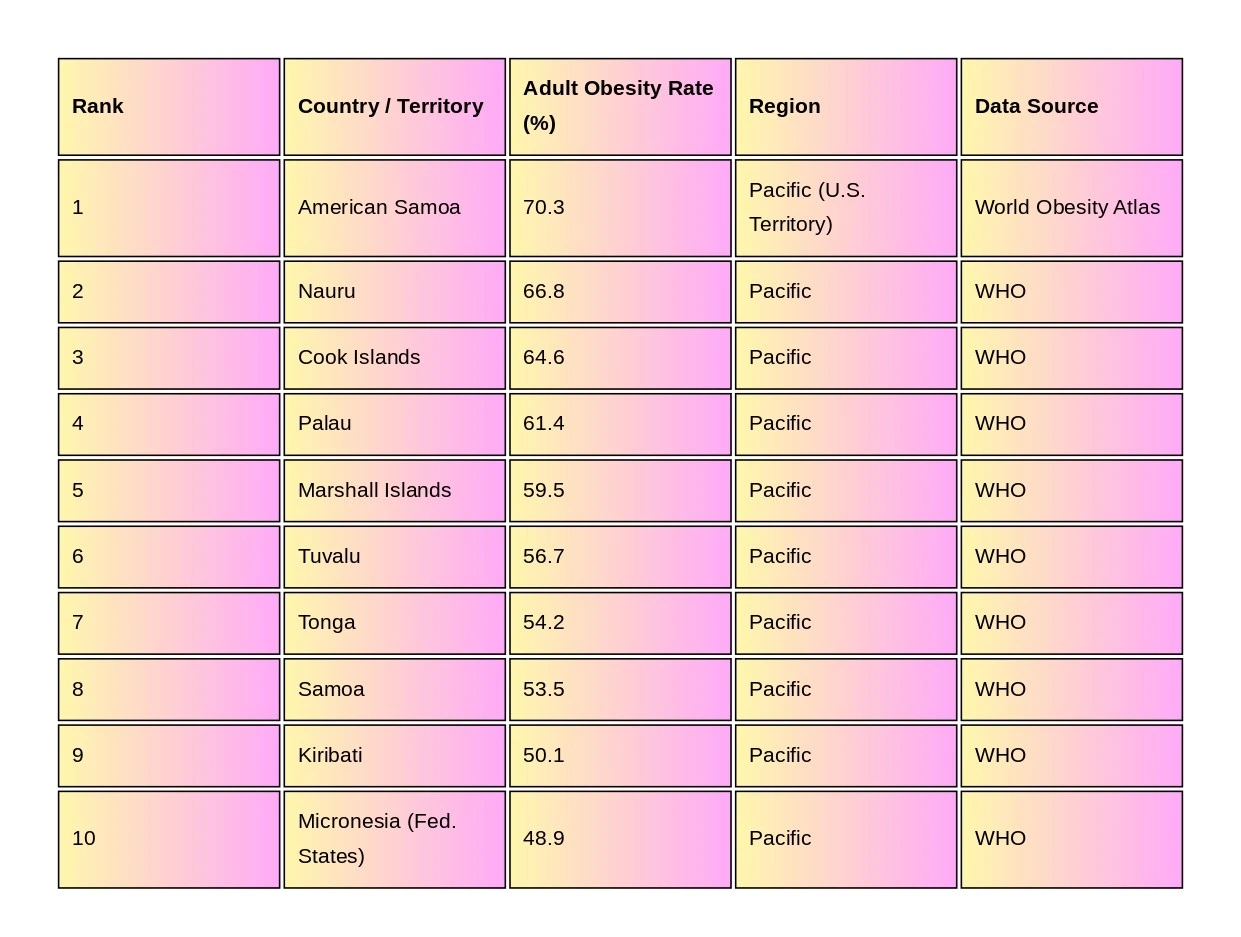Introduction: The Hidden Obesity Capital of the World
When people discuss global obesity statistics, countries like the United States or Saudi Arabia often dominate the conversation. Yet, the most obese country in the world is American Samoa, a small island territory in the South Pacific.
According to the World Obesity Atlas 2024, around 70% of adults in American Samoa are obese, and nearly 90% are overweight. Understanding why this tiny island tops global obesity rankings reveals how genetics, modernization, and cultural values intersect.

Observation: The Pacific region dominates the top ten, proving that the obesity crisis there is both regional and systemic.
1. Genetic Predisposition: The “Thrifty Gene” HypothesisScientists have long studied the genetic makeup of Polynesian populations to understand why obesity rates are so high. The “thrifty gene” theory suggests that these populations evolved to store energy efficiently, a survival advantage during long sea voyages and food scarcity.
In today’s environment of abundant calories, this genetic trait backfires, making American Samoans more prone to obesity even with moderate food intake.
2. Dietary Shift: From Traditional Foods to Processed ImportsThe traditional Samoan diet once featured fish, taro, coconut, breadfruit, and tropical fruits—all nutrient-dense and low in calories. However, with globalization came a rapid dietary westernization:
High consumption of canned corned beef, instant noodles, and sweetened beverages
Decline in fishing and agriculture
Reliance on imported processed food due to affordability and availability
Result: A massive jump in caloric intake without corresponding physical activity, fueling obesity and diabetes.
3. Economic Dependence and Limited Local ProductionAmerican Samoa imports nearly 85 % of its food supply. Shipping costs make healthy options expensive, while processed foods remain cheap and shelf-stable.
The territory’s limited agricultural infrastructure, combined with low median income, leaves residents with few healthy choices.
4. Cultural Beliefs Around Body SizeIn many Pacific Island societies, a larger body size symbolizes wealth, strength, and health. This cultural perspective reduces social stigma toward obesity.
Moreover, celebrations and family gatherings often revolve around large communal feasts, reinforcing high-calorie consumption as part of cultural pride.
5. Sedentary Lifestyle and UrbanizationPhysical activity among American Samoans has dropped sharply over recent decades.
Office and service jobs have replaced physically demanding labor.
Vehicle use has replaced walking.
High humidity and lack of fitness facilities discourage outdoor exercise.
This lifestyle change complements the diet shift to produce a dangerous energy imbalance.
6. The Public Health Consequences
The long-term outcomes of high obesity rates are devastating:
Over 40 % of adults have Type 2 diabetes
Rising rates of cardiovascular disease and hypertension
Shortened life expectancy compared to global averages
Hospitals struggle to manage chronic conditions, and the healthcare system remains underfunded.
7. Lessons from Global Obesity StatisticsThe case of American Samoa mirrors a global pattern:
Urbanization → less movement
Processed food imports → higher calorie intake
Cultural adaptation lag → old habits in new contexts
Countries across Africa, Asia, and Latin America are now following the same trend, showing that obesity is not just a personal issue but a global structural problem.
8. What Can Be DoneSolutions must be locally driven yet globally informed:
Promote traditional diets rich in local produce and fish.
Tax sugary beverages and ultra-processed foods.
Subsidize local agriculture to reduce import dependency.
Integrate nutrition education into schools and community centers.
Develop community fitness programs suited to local climate and culture.
9. The Broader TakeawayAmerican Samoa’s obesity crisis teaches a universal lesson: when cultural heritage meets global consumerism without balance, health deteriorates. Combating obesity requires aligning policy, tradition, and modern science.
ConclusionThe world’s most obese country, American Samoa, stands as both a warning and a roadmap. Genetic makeup, economic reliance, and globalization together explain its staggering obesity rate.
Understanding these dynamics is crucial for countries on the same trajectory — before it’s too late.
